Air
Intake
With
four large generators to supply, the power house required an air
handling system that was a structure all unto itself. Connected
to the north hemisphere of the Power House's mezzanine level by a
9-foot 6-inch diameter tunnel, the filtration and conditioning
equipment was located in a 15-foot 6-inch diameter section oriented
perpendicular to the access tunnel.
|
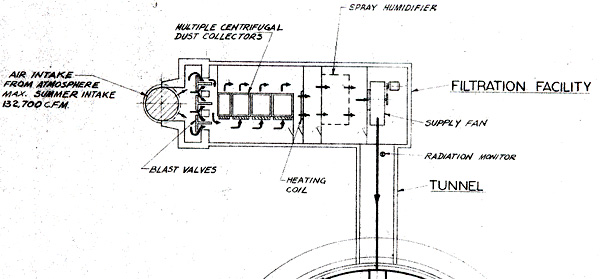
Power
House Air Filtration Facility - Top view
|
The
above diagram shows the airflow through the air intake facility-- it
descends about 30 feet from the surface and passes through the blast
valves (5 valves, each 60 inches in diameter) before entering the
filtration facility. The filtration facility is divided
longitudinally on the left half by a large plenum and array of
centrifugal dust collectors. The air would flow through the dust
collectors where it would be forced through small cylindrical channels
that would cause a vortex motion of the air which would precipitate
dust and other particles out so they would drop into a collection
hopper below as the air passed out the other side of the array.
|
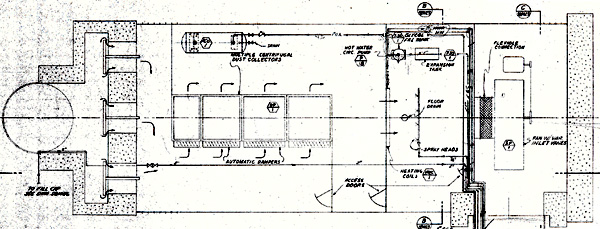
Power
House Air Filtration Facility - Top view detail
|
Once
on the other side of the dust collectors the partially filtered air
would pass through a large set of ethylene glycol heating coils over 2
stories high where it would be heated to around 55 degrees F if the
outside temperature was lower. Next the air would be humidified
by a sprayed coil humidifier which simply consisted of a series of 10
spray nozzles which added moisture to the incoming air.
|
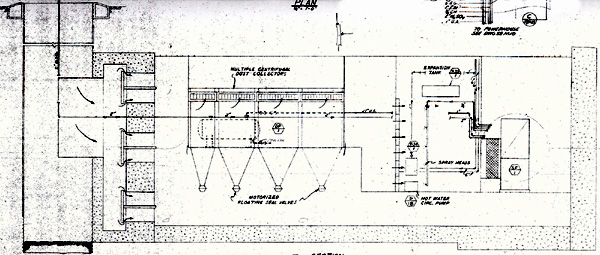
Power
House Air Filtration Facility - Side aspect
|
From
the humidifier the air moved into a very large Trane Co. squirrel cage
fan with variable inlet vanes to control the rate of flow. This
fan forced the air into the Power House and the generators at a
maximum rate of 132,700 cubic feet per minute.
|
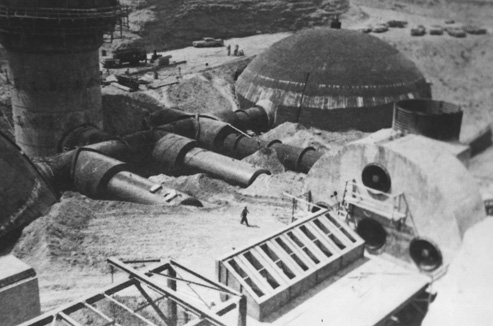
Construction
photo of the Power House filtration facility showing the slanted
cyclonic dust collector array and the 60" blast valves before the corrugated
liner was emplaced. The Control Center dome is visible toward the
upper right and the 30,000 gallon raw water tanks are located just
behind the figure walking in the center of the photo.
|
|
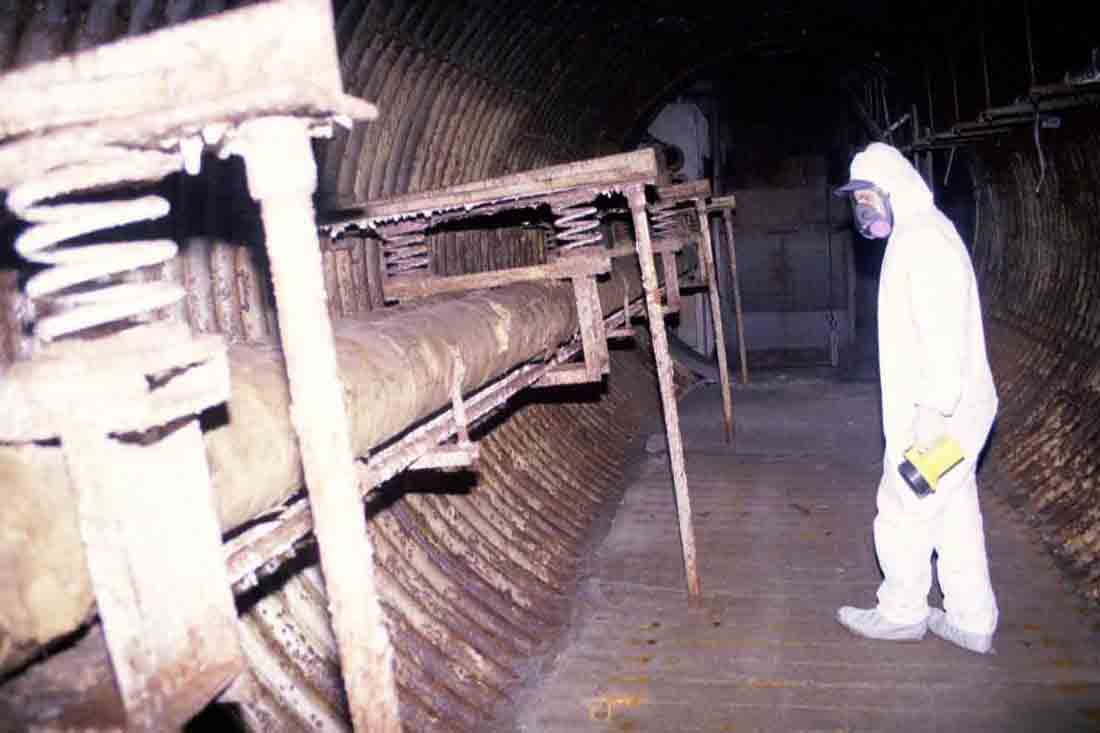
Silo
Gnome inspects some shock-mounted ethylene glycol lines in the tunnel
connecting the Power House and the filtration facility. A very
large fan is visible at the end of the tunnel where the structure heads
90 degrees off to the left.
|
Since
the first 2 Titan bases were constructed in Colorado, (or squadrons if
you prefer. Martin Co. designated the Lowry sites as T-1 in their
documentation) there were many design modifications in the later Titan
facilities. The largest physical change in the Titan complexes
built in California, South Dakota, Idaho and Washington was in the Power
House air intake and exhaust facilities. The
air intake and exhaust facilities were changed from a predominantly
horizontal configuration to a vertical stack which comprised far less
space and materials with a more efficient design. I have been
unable to see this design difference for myself. I have seen a few
photos taken during site remediation by the US Army of Engineers, but
they are dreadfully low quality and there are precious few of
them. If anyone has any good pictures of the air handling
structures from the other bases I'd be very appreciative if they could
contact me.
|
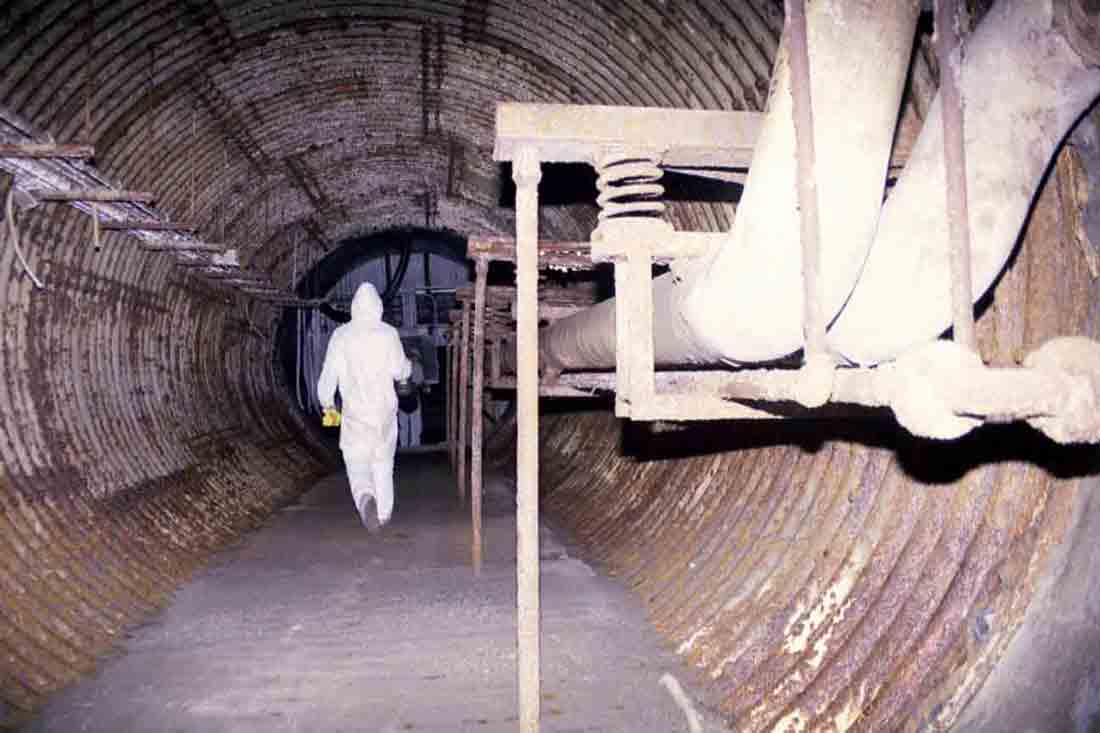 Looking toward the Power
House from inside the filtration facility's connecting tunnel. The
lines here are ethylene glycol supply and return lines used to heat
incoming the air.
Looking toward the Power
House from inside the filtration facility's connecting tunnel. The
lines here are ethylene glycol supply and return lines used to heat
incoming the air.
|
On
an odd side note I am rather interested in the Trane equipment at the
Titan sites. The fan in these pictures were manufactured at the
Trane facility in LaCrosse Wisconsin and shipped to Denver by
railcar. The reason for my interest is that I had an uncle who was
employed as a welder at the LaCrosse plant during the 60's and 70's (now
deceased, may he rest in peace) and I cannot help wondering if he took
part in the fabrication of some of the very large air handling equipment
installed at the Titan I sites.
|
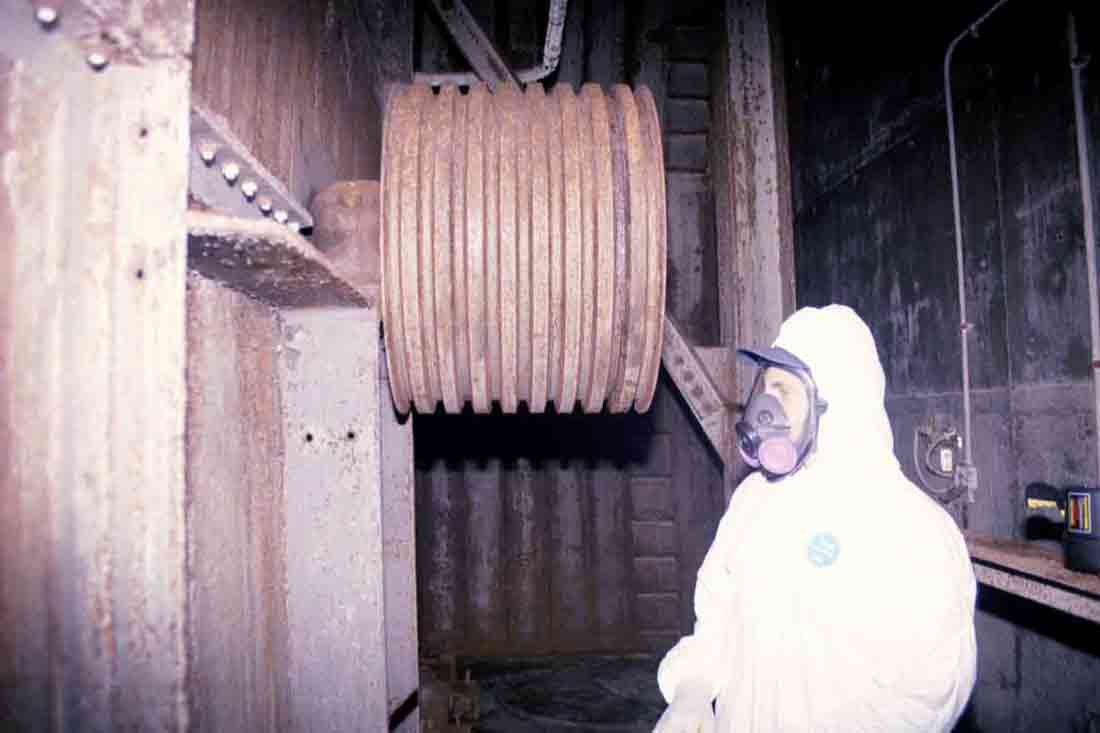 Standing beside the Trane
Co. squirrel cage fan in full mesothelioma-resistant gear I am
dwarfed. I happen to be just shy of 6 feet tall, so I estimate
this unit to stand around 13 feet tall! The sheave (where the
drive belts run) takes an impressive 9 belts so I know this fan is no
lightweight. Interestingly, the bearings still moved smoothly and
easily by hand even after 40 years.
Standing beside the Trane
Co. squirrel cage fan in full mesothelioma-resistant gear I am
dwarfed. I happen to be just shy of 6 feet tall, so I estimate
this unit to stand around 13 feet tall! The sheave (where the
drive belts run) takes an impressive 9 belts so I know this fan is no
lightweight. Interestingly, the bearings still moved smoothly and
easily by hand even after 40 years.
|
Just
beyond this point a radiation monitor would detect incoming fallout if
it entered the complex. If detected, an indicator would light on
the facilities console in the Control Center indicating radiation in the
Power House, alerting the crew to close the blast valves.
Detectors were also located in the Launcher Air Filtration Facility, the
Control Center and on the surface to alert the crew of a radiation
hazard existing outside the complex.
The
entire platform supporting the fan, heat exchanger, expansion tank,
large drive motor and other equipment was suspended in a large steel
framework such that it "floated". This was both for
shock-mounting and vibration damping, but produced some interesting and
unintended effects.
|
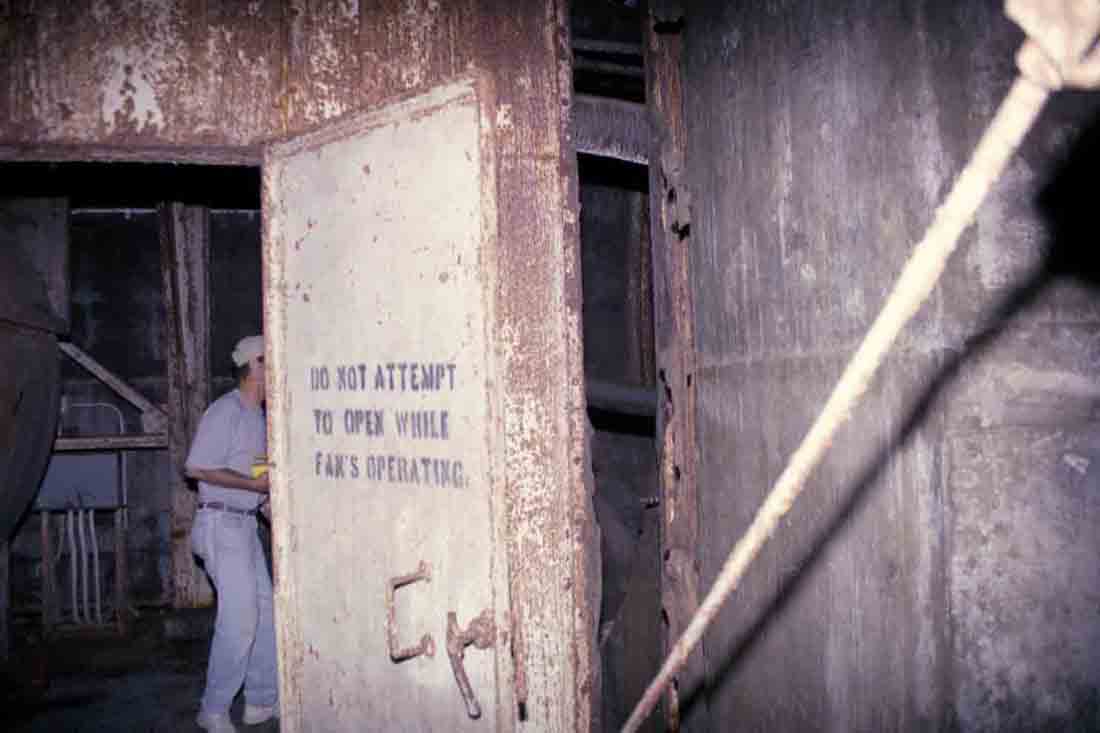 Looking from the fan area
into the humidification and heating area. The door's warning is
certainly valid as there would be tremendous pressure on it with the fan
running. To open this door under pressure would be a great way to
have your teeth/nose knocked in. The humidity in this area has
greatly accelerated the oxidation and decay of metal and seals.
The neoprene seal which used to occupy the space in the middle of the
photo has disintegrated almost completely in contrast with the mostly
intact seals found in the rest of the complex.
Looking from the fan area
into the humidification and heating area. The door's warning is
certainly valid as there would be tremendous pressure on it with the fan
running. To open this door under pressure would be a great way to
have your teeth/nose knocked in. The humidity in this area has
greatly accelerated the oxidation and decay of metal and seals.
The neoprene seal which used to occupy the space in the middle of the
photo has disintegrated almost completely in contrast with the mostly
intact seals found in the rest of the complex.
|
On
windy days (the majority of days in the area of the Lowry complexes) air
forced down through the intake tunnel would pass through the structure
and set the large steel plenums and threaded struts (one is visible in
the above photo) to resonating. The resulting vibration produced a
very disconcerting and eerie low thrumming sound that would make your
hair stand on end. That's precisely what it did the first time I
heard it along with a tour group who was visiting 1-C for the first
time. We all froze and listened as a deep rumble reverberated
inside the dome of the Power House's ceiling like a huge machine coming
to life. It sounded as though the Titan was waking up around us!
After
thoroughly soiling ourselves we tried to locate the source of the spooky
noise and traced it to the filtration facility where we found the steel
supports and walls vibrating like strings on a bass fiddle. The
tunnels and warrens of the Titan complex make excellent conduits for
channeling sound it turns out.
|
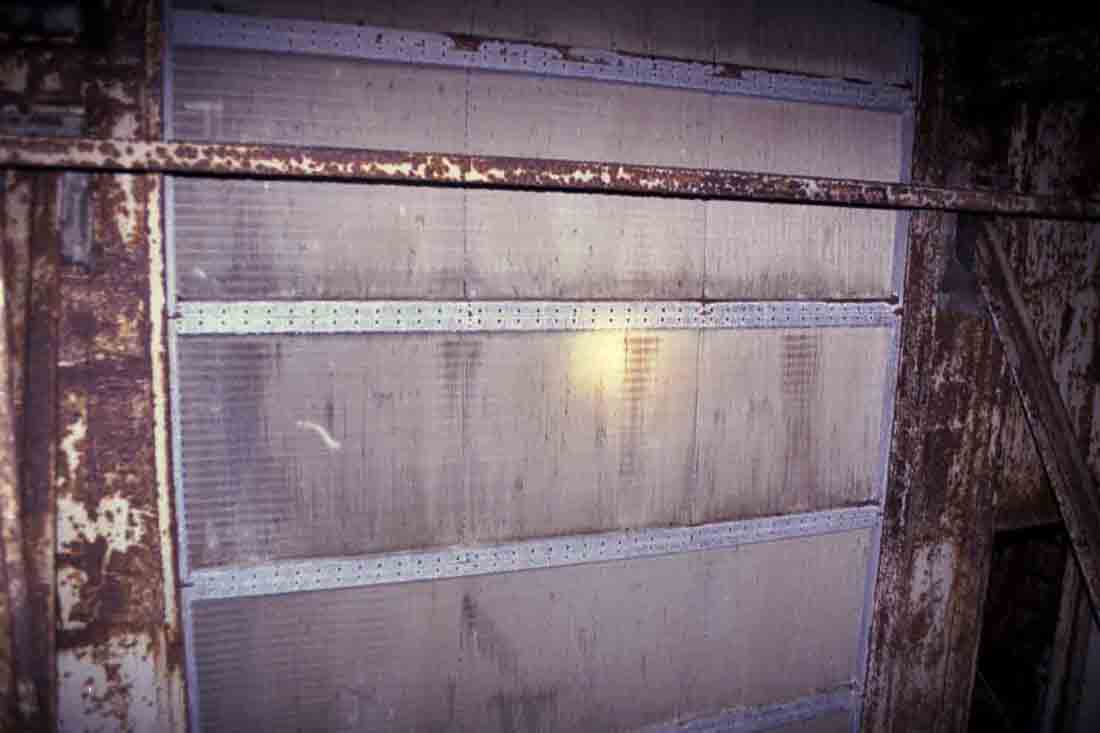 The heating coils, which
stand nearly 16 feet in height. These were heated by hot water
from the Power House boilers which passed through a heat
exchanger. Air flow would be from the perspective of this photo
and through the coils. The personnel access door is visible at the
lower right.
The heating coils, which
stand nearly 16 feet in height. These were heated by hot water
from the Power House boilers which passed through a heat
exchanger. Air flow would be from the perspective of this photo
and through the coils. The personnel access door is visible at the
lower right.
|
That
deep serenade in the Power House wasn't the first time the acoustic
properties of the Titan had freaked me out. Years earlier I was
working to clean dirt, rust, paint chips and other filth out of the
Entry Portal stairway using an industrial HEPA vac. The vacuum
looked like an overgrown shop vac and made a hell of a racket as I
worked my way down the dark steps cleaning up 40 years' work of crud. It
was deafening in there with the vac on so I had foam earplugs crammed in
my skull to preserve what hearing I had, and I was wearing a full-face
respirator and full body suit. I looked suspiciously like the silo
gnome in some of the pictures in fact. Despite the plugs, I could
still hear the vacuum running quite well. As
I toiled in the area of the revolving security door, the vacuum seemed to
start making a strange noise and changed pitch. Using my
handyman's repertoire, I soundly beat the vacuum with my hand hoping to
rectify the trouble. When this method failed I switched off the
unit to inspect it. To my surprise the industrial roar of the
vacuum did not stop. Puzzled,
I flipped the switch on and off several times, but the sound persisted,
which confused me greatly. I felt the vacuum; it was not vibrating
so it had to be off. I stood up and removed my earplugs and the
sound became much louder with a deep thumping that I could feel in
my chest! "What
the hell?" I said, heading up the steps to the surface. The
more I ascended, the louder the sound became and the more pronounced the
staccato pressures buffeted me. I
emerged on the surface in time for about 4 Black Hawk helicopters (undoubtedly
from nearby Buckley Air National Guard) to fly
low right over the complex and myself. Dressed as I was, I am not
sure who was more surprised. It's not every day you see a guy
dressed like that pop out of the ground! It
was really surprising how well the sound of the choppers channeled its
way down into the complex. I must have been hearing them from more
than 10 miles off before I went topside, and then it was through the
sound of an industrial vacuum and earplugs while 16 feet underground and
surrounded by concrete!
|
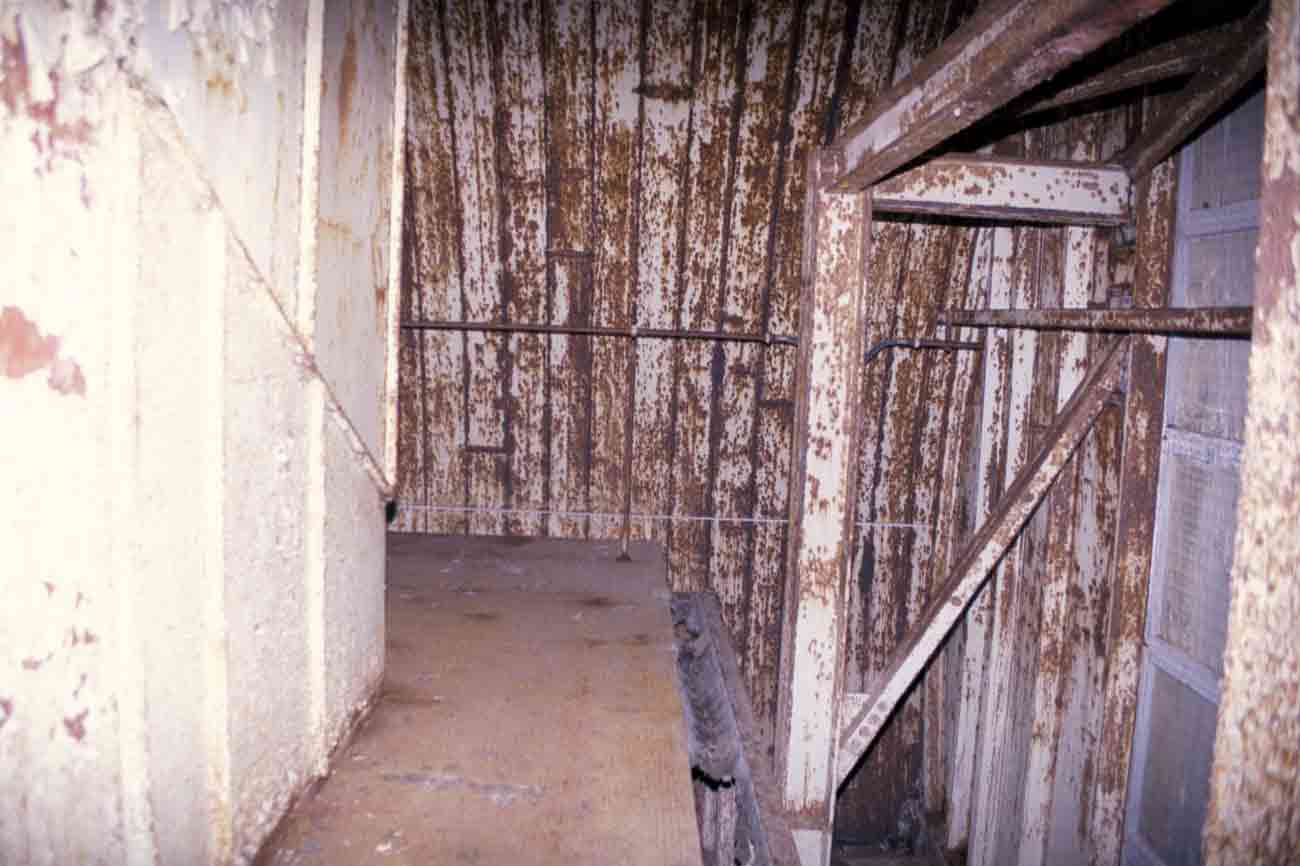 View from between the dust collectors
(left) and the heating coils (at right).
View from between the dust collectors
(left) and the heating coils (at right).
|
|
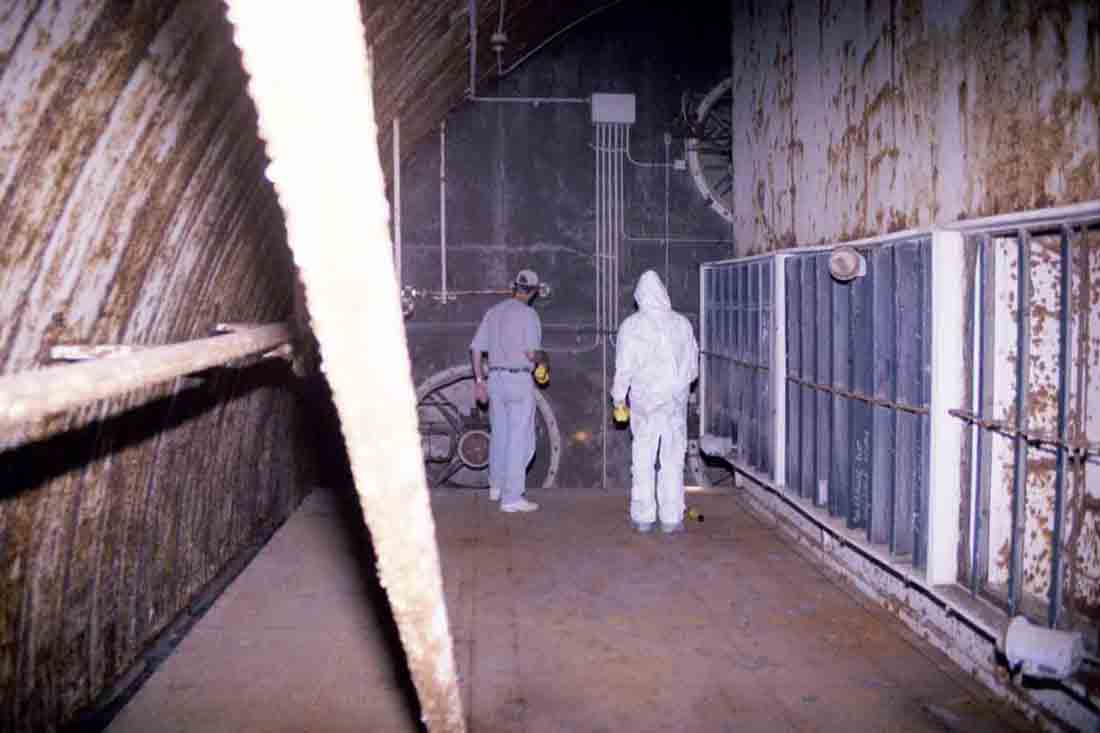 This side of the filtration
facility is where air enters the cyclonic dust separators through the
dampers at the right. The Blast valves are visible at the
end. This platform is about 7 feet above the lower level where the
dust collector's hoppers could be serviced. The lower level at
site 724-C was at different times flooded or mired with very nasty
mud. Needless to say I never ventured below.
This side of the filtration
facility is where air enters the cyclonic dust separators through the
dampers at the right. The Blast valves are visible at the
end. This platform is about 7 feet above the lower level where the
dust collector's hoppers could be serviced. The lower level at
site 724-C was at different times flooded or mired with very nasty
mud. Needless to say I never ventured below.
|
Back
on track! The blast valves were still open, but despite the urge
to try to pass thru them to the other side, both a long drop and a moat
of nasty water stood between me and my curiosity. I've also been
told that the valves are also under tremendous spring pressure and there
is no guarantee that disturbing them to squeeze through would not cause
them to snap shut. Not a pretty picture.
|
 A better view of one of the blast valves.
There exists a gap of about 8' or more between the platform on which we
stood in this picture and the concrete firewall through which the blast
valves penetrate. The gap, which had several feet of water at the
bottom, made for an effective deterrent to keep us from messing with the
spring-loaded valves. This picture gives an idea of the
thickness of the concrete slab which protects the interior of the
complex.
A better view of one of the blast valves.
There exists a gap of about 8' or more between the platform on which we
stood in this picture and the concrete firewall through which the blast
valves penetrate. The gap, which had several feet of water at the
bottom, made for an effective deterrent to keep us from messing with the
spring-loaded valves. This picture gives an idea of the
thickness of the concrete slab which protects the interior of the
complex.
|
Apparently,
there's not much to see in the air intake shaft anyway-- its simply a
corrugated steel liner and a few service conduits running to the
surface. At 724-C, the Power House intake and exhaust shafts have
been sealed over using what appears to be scrap steel salvage from the
complex to keep intruders out. A large "cap" covers the
approximately 65' deep shaft, which has water of an indeterminate depth
at the bottom. Depending on the season, this water spills over
into the filtration facility through the blast valves and makes its way
into the Power House and down the two deep wells at the bottom of the
pipe trench.
|
 Another view of the firewall
and a blast valve. On the left you can see a 2" sulfuric acid
(H2SO4) fill line which runs to one of the many
tanks comprising the process water system in the Power House. This
also shows the effective aforementioned "gap" we were loathe
to try and cross.
Another view of the firewall
and a blast valve. On the left you can see a 2" sulfuric acid
(H2SO4) fill line which runs to one of the many
tanks comprising the process water system in the Power House. This
also shows the effective aforementioned "gap" we were loathe
to try and cross.
|
|
 One more look at a 60"
blast valve. This is the center valve with four more valves
arranged at each compass point around it.
One more look at a 60"
blast valve. This is the center valve with four more valves
arranged at each compass point around it.
|
|
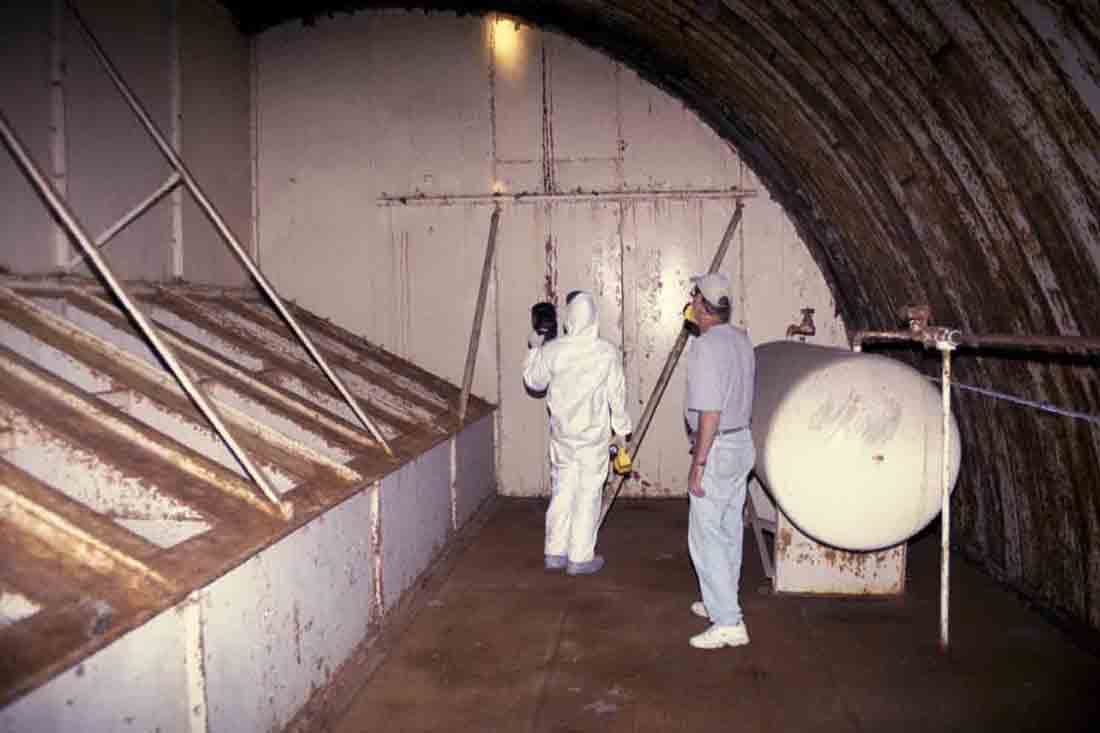 This is the exit side of the
dust collectors (at left) and is closed off from the blast valves.
These tall steel walls or plenums which achieved this separation are in
large part what was creating the unsettling vibrations and sounds
detailed earlier in this section. A large utility air pressure
accumulator tank was located here for keeping pressure on the humidification
spray heads and probably supplied the pneumatic dampers and inlet vane
controls as well.
This is the exit side of the
dust collectors (at left) and is closed off from the blast valves.
These tall steel walls or plenums which achieved this separation are in
large part what was creating the unsettling vibrations and sounds
detailed earlier in this section. A large utility air pressure
accumulator tank was located here for keeping pressure on the humidification
spray heads and probably supplied the pneumatic dampers and inlet vane
controls as well.
|
Air
flow moved up out of the dust collectors and on to the heating coils and
humidification spray heads before being forced onward to the Power House
by the fan and consumed by the generators and supplying the remaining
structure with fresh air. me
of the sites were turned over to the original landowners; some sites
remained government property until most were sold at auction along with
abandoned Atlas sites and other surplus military property.
From
here you can head back to the Power House,
check out the Power House Exhaust,
return to the Main Tunnel Junction
(T.J.#10) or visit other points of interest using the map
below:
Current
Location: Power House Air Intake
|
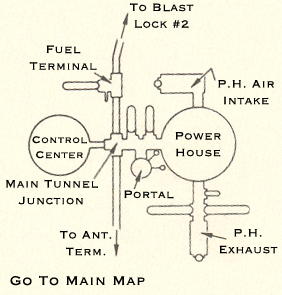
Where
would you like to go next?
|

|
Contact
| Site Map | Links |
Hosted by
InfoBunker

|

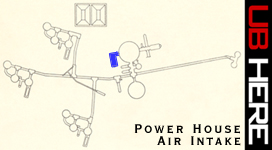





 Looking toward the Power
House from inside the filtration facility's connecting tunnel. The
lines here are ethylene glycol supply and return lines used to heat
incoming the air.
Looking toward the Power
House from inside the filtration facility's connecting tunnel. The
lines here are ethylene glycol supply and return lines used to heat
incoming the air. Standing beside the Trane
Co. squirrel cage fan in full mesothelioma-resistant gear I am
dwarfed. I happen to be just shy of 6 feet tall, so I estimate
this unit to stand around 13 feet tall! The sheave (where the
drive belts run) takes an impressive 9 belts so I know this fan is no
lightweight. Interestingly, the bearings still moved smoothly and
easily by hand even after 40 years.
Standing beside the Trane
Co. squirrel cage fan in full mesothelioma-resistant gear I am
dwarfed. I happen to be just shy of 6 feet tall, so I estimate
this unit to stand around 13 feet tall! The sheave (where the
drive belts run) takes an impressive 9 belts so I know this fan is no
lightweight. Interestingly, the bearings still moved smoothly and
easily by hand even after 40 years. Looking from the fan area
into the humidification and heating area. The door's warning is
certainly valid as there would be tremendous pressure on it with the fan
running. To open this door under pressure would be a great way to
have your teeth/nose knocked in. The humidity in this area has
greatly accelerated the oxidation and decay of metal and seals.
The neoprene seal which used to occupy the space in the middle of the
photo has disintegrated almost completely in contrast with the mostly
intact seals found in the rest of the complex.
Looking from the fan area
into the humidification and heating area. The door's warning is
certainly valid as there would be tremendous pressure on it with the fan
running. To open this door under pressure would be a great way to
have your teeth/nose knocked in. The humidity in this area has
greatly accelerated the oxidation and decay of metal and seals.
The neoprene seal which used to occupy the space in the middle of the
photo has disintegrated almost completely in contrast with the mostly
intact seals found in the rest of the complex. The heating coils, which
stand nearly 16 feet in height. These were heated by hot water
from the Power House boilers which passed through a heat
exchanger. Air flow would be from the perspective of this photo
and through the coils. The personnel access door is visible at the
lower right.
The heating coils, which
stand nearly 16 feet in height. These were heated by hot water
from the Power House boilers which passed through a heat
exchanger. Air flow would be from the perspective of this photo
and through the coils. The personnel access door is visible at the
lower right. View from between the dust collectors
(left) and the heating coils (at right).
View from between the dust collectors
(left) and the heating coils (at right). This side of the filtration
facility is where air enters the cyclonic dust separators through the
dampers at the right. The Blast valves are visible at the
end. This platform is about 7 feet above the lower level where the
dust collector's hoppers could be serviced. The lower level at
site 724-C was at different times flooded or mired with very nasty
mud. Needless to say I never ventured below.
This side of the filtration
facility is where air enters the cyclonic dust separators through the
dampers at the right. The Blast valves are visible at the
end. This platform is about 7 feet above the lower level where the
dust collector's hoppers could be serviced. The lower level at
site 724-C was at different times flooded or mired with very nasty
mud. Needless to say I never ventured below. A better view of one of the blast valves.
There exists a gap of about 8' or more between the platform on which we
stood in this picture and the concrete firewall through which the blast
valves penetrate. The gap, which had several feet of water at the
bottom, made for an effective deterrent to keep us from messing with the
spring-loaded valves. This picture gives an idea of the
thickness of the concrete slab which protects the interior of the
complex.
A better view of one of the blast valves.
There exists a gap of about 8' or more between the platform on which we
stood in this picture and the concrete firewall through which the blast
valves penetrate. The gap, which had several feet of water at the
bottom, made for an effective deterrent to keep us from messing with the
spring-loaded valves. This picture gives an idea of the
thickness of the concrete slab which protects the interior of the
complex. Another view of the firewall
and a blast valve. On the left you can see a 2" sulfuric acid
(H2SO4) fill line which runs to one of the many
tanks comprising the process water system in the Power House. This
also shows the effective aforementioned "gap" we were loathe
to try and cross.
Another view of the firewall
and a blast valve. On the left you can see a 2" sulfuric acid
(H2SO4) fill line which runs to one of the many
tanks comprising the process water system in the Power House. This
also shows the effective aforementioned "gap" we were loathe
to try and cross. One more look at a 60"
blast valve. This is the center valve with four more valves
arranged at each compass point around it.
One more look at a 60"
blast valve. This is the center valve with four more valves
arranged at each compass point around it. This is the exit side of the
dust collectors (at left) and is closed off from the blast valves.
These tall steel walls or plenums which achieved this separation are in
large part what was creating the unsettling vibrations and sounds
detailed earlier in this section. A large utility air pressure
accumulator tank was located here for keeping pressure on the humidification
spray heads and probably supplied the pneumatic dampers and inlet vane
controls as well.
This is the exit side of the
dust collectors (at left) and is closed off from the blast valves.
These tall steel walls or plenums which achieved this separation are in
large part what was creating the unsettling vibrations and sounds
detailed earlier in this section. A large utility air pressure
accumulator tank was located here for keeping pressure on the humidification
spray heads and probably supplied the pneumatic dampers and inlet vane
controls as well.

